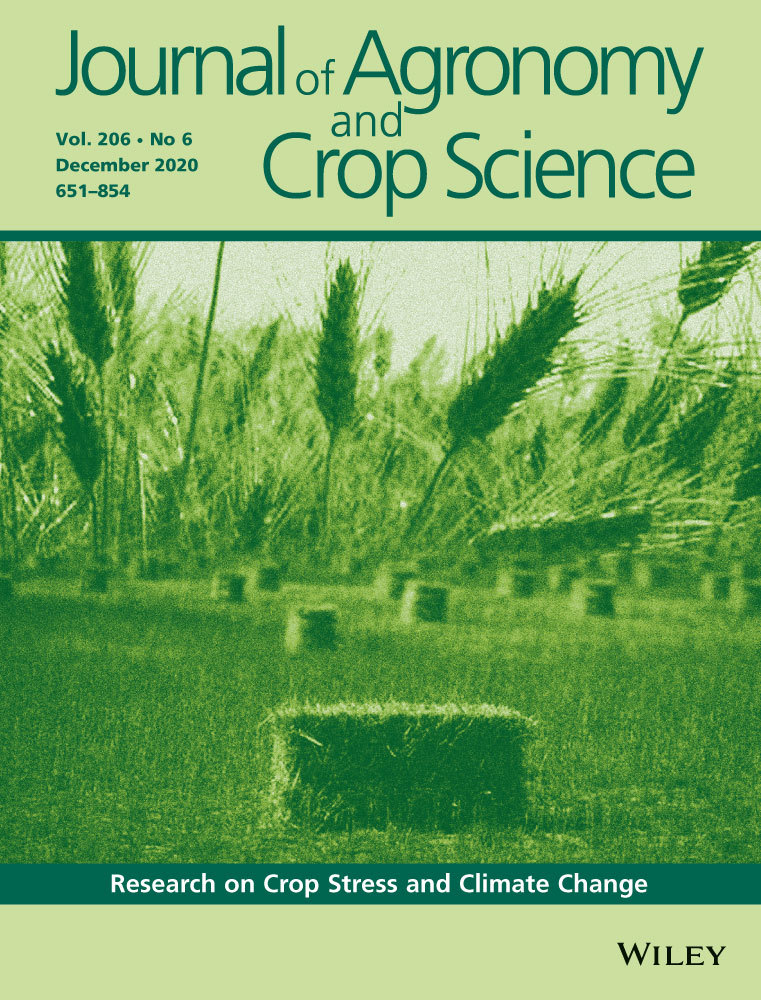Ver ítem
- xmlui.general.dspace_homeCentros Regionales y EEAsCentro Regional Buenos Aires SurEEA Cuenca del SaladoArtículos científicosxmlui.ArtifactBrowser.ItemViewer.trail
- Inicio
- Centros Regionales y EEAs
- Centro Regional Buenos Aires Sur
- EEA Cuenca del Salado
- Artículos científicos
- Ver ítem
Morpho‐physiological, biochemical and isotopic response of tall wheatgrass populations to salt stress
Resumen
Tall wheatgrass [Elymus elongatus subsp. ponticus (Podp.) Melderis] is a C3 grass native from dry or saline habitats in SE Europe. The aim of this study was to better understand response mechanisms of populations from different origins to salinity and to provide new tools to select germoplasm with high salinity tolerance. Four populations (P3‐P4‐P5‐P9) were irrigated with five solutions of increasing salinity (Salt: 0–0.1–0.2–0.3–0.4 M NaCl) and evaluated
[ver mas...]
Tall wheatgrass [Elymus elongatus subsp. ponticus (Podp.) Melderis] is a C3 grass native from dry or saline habitats in SE Europe. The aim of this study was to better understand response mechanisms of populations from different origins to salinity and to provide new tools to select germoplasm with high salinity tolerance. Four populations (P3‐P4‐P5‐P9) were irrigated with five solutions of increasing salinity (Salt: 0–0.1–0.2–0.3–0.4 M NaCl) and evaluated in pots in a greenhouse. Two experiments were carried out, a short 40‐day long experiment with vegetative plants, and a longer 85‐day long one with plants that underwent vegetative‐reproductive stage. No evidence was found of an interaction between population and salt. Morpho‐physiological, biochemicals, isotopic and productive variables were differently affected by increasing salinity and were also different among populations. Proline, Na+ and Cl− consistently appeared to function as osmotic agents. P5 showed the highest biomass in the 85‐day experiment and had the highest leaf length, tiller density, water use efficiency and δ13C isotope; and the lowest Cl− concentration and evapotranspiration rate. However, P5 showed the lowest biomass in the 40‐day experiment, suggesting that duration of the stress is an important aspect to consider when selecting germoplasm for tolerance to salinity. Differences among populations in growth strategies and physiological mechanisms could be related to their origin environment.
[Cerrar]

Autor
Borrajo, Celina Ines;
Sánchez‐Moreiras, Adela M.;
Reigosa, Manuel J.;
Fuente
Journal of Agronomy and Crop Science (First published: 05 December 2020)
Fecha
2020-12
Editorial
Wiley
ISSN
1439-037X
Formato
pdf
Tipo de documento
artículo
Palabras Claves
Derechos de acceso
Restringido
 Excepto donde se diga explicitamente, este item se publica bajo la siguiente descripción: Creative Commons Attribution-NonCommercial-ShareAlike 2.5 Unported (CC BY-NC-SA 2.5)
Excepto donde se diga explicitamente, este item se publica bajo la siguiente descripción: Creative Commons Attribution-NonCommercial-ShareAlike 2.5 Unported (CC BY-NC-SA 2.5)

